
Department news
News
Life in the fast lane
On June 22, amateur racer Dino Crescentini, lost his life on the Mosport International Raceway in Bowmanville, Ont. As a professional firefighter for 30 years, with 20 years on a heavy rescue, I wondered who makes up the safety teams that respond in professional motor sports events.
November 17, 2008
By Keith Hamilton
Thrill of race track entices local firefighters, paramedics to pull double duty
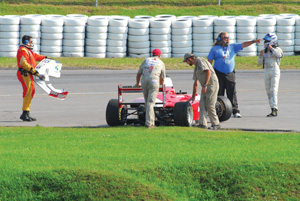 |
| Typical safety team work includes ensuring that the driver is OK and cleaning up the track so the race can continue. Photo by Keith Hamilton |
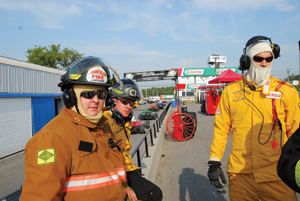 |
| Pit-lane safety members include local volunteers from the Mosport area. Photo by Keith Hamilton |
On June 22, amateur racer Dino Crescentini, lost his life on the Mosport International Raceway in Bowmanville, Ont. As a professional firefighter for 30 years, with 20 years on a heavy rescue, I wondered who makes up the safety teams that respond in professional motor sports events. Local volunteers who supply fire, safety and medical assistance to motor sports made up the safety crew that responded to this incident. I met these volunteers while spending time at the track as a spectator. When I heard about last summer’s American Le Mans Series race by the International Motor Sports Association (IMSA), I wondered how professional auto sports extrication teams compare to professional firefighter extrication teams? It turns out they’re the same people. Most of the team members are full-time firefighters with EMTs and paramedics completing the roster.
Lee Bailie of Mosport media relations introduced me to the head of IMSA public relations, Bob Dickinson, who further introduced me to the IMSA rescue team boss John Zilles. At Mosport, Zilles led a group of three rescue trucks, each with a crew of four safety members. He drove the medical response vehicle, a Porsche Cayenne Turbo with the medical director of IMSA on board, Dr. Gregg Summerville. There were 15 team members at the race track, not including dispatchers. There were some Canadians on the team, including a paramedic from the Region of Peel (north/west of Toronto) in Ontario. The team consists of mostly professional firefighters – active and retired – paramedics and EMTs. The firefighters also have EMT skills, which are helpful but not usually needed due to the IMSA medical team and local doctors on site. Race cars are built to be safe from crash hazards with roll cages, safety fuel cells, on-board fire extinguishers and external power cut switches. The No. 1 duty of the safety team would be to tend to the driver’s health with fire and extrication on immediate standby.
Riding along with Zilles was a guest firefighter from Montreal, Denis Cadotte, who was observing the safety team to see about being part of the Canadian contingent.
The rescue equipment loaded on two of the safety trucks is supplied by Amkus Rescue Systems. The heavy hydraulics kit consists of a power unit with a spreader and shears, with the shears being the main tool used for extrication. Fire fighting is accomplished with alcohol-type foam. This foam is used because of the need to deal with diesel, gas and ethanol 85. Another bonus is that the foam is easily removed from the track.
Crews are not just responsible for fires and extrication but also for keeping the track safe for drivers. A third rescue truck has a heavy suspension and carries a large supply of dry powder extinguishing agent and is used to tow stranded race cars that still have all their tires attached. Often, the safety team will be responsible, along with the track-side workers, for cleaning up debris from the track surface so the race can continue.
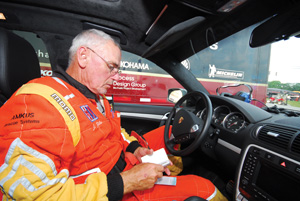 |
| John Zilles, safety team leader and medical response vehicle driver in the cockpit of the Porsche Cayenne Turbo. Photo by Keith Hamilton |
Safety is not confined just to vehicles that are on the track; it is imperative that vehicle safety checks are done before the cars are allowed on the track. IMSA has a full technical inspection team that
makes sure vehicles stay within the specification rules; it also make sure vehicles have the appropriate safety equipment in good working order.
It was pointed out that hazards faced by the safety team are different than those faced by municipal firefighters because race-car drivers have above-average skills, are not impaired and are driving in the same direction. Another difference is that when approaching a race car involved in an accident, rescuers can generally assume that a driver’s medical problems are due to trauma and not other medical reasons. The track workers use a flag system that notifies other racers of accidents and slow emergency vehicles on the track, making the track safer than an ordinary highway.
Zilles is from Green Bay Wisconsin and started his IMSA career as a rescue equipment retailer who volunteered for the local fire department. He also became a paramedic and the sales representative for Amkus tools. As if that weren’t enough, he also became an instructor, initially for EMTs and then for Amkus extrication equipment. He has travelled to more than 50 countries to teach auto extrication and share advice on fire fighting and emergency medical treatment.
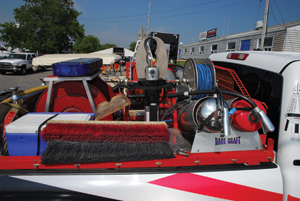 |
| Safety truck standard tools include Amkus spreaders and cutters, pre-plumbed extinguishers, alcohol foam and track-cleaning equipment. Photo by Keith Hamilton |
In 1989, Zilles was asked by IMSA to assist with a safety team by transporting emergency doctors to the accident sites and then helping and directing rescues. He passed his competition licence so he could drive the medical vehicle on the track.
Since then, IMSA and Zilles have worked to create a team of more than 20 dedicated rescue crew personnel that travels to series events for very modest compensation.
I went to Mosport with the intention of meeting with the IMSA safety team because they are professionals who travel with the series around the continent. I would be remiss, however, if I didn’t comment on the contingent of Ontarians and Canadians who travel across Canada to assist at these motorsports events. The race track has many events that aren’t affiliated with IMSA but also require rescue teams and safety volunteers. These local team members are full-time, volunteer or in-training firefighters, paramedics, nurses and doctors from various Canadian municipalities. They volunteer their time for little or no compensation because of their love of the sport. All the safety team members on the pit lane consist of these good folks because the IMSA rescue crews are placed strategically around the race track to respond immediately to an on-track event. A race couldn’t be held without these volunteer workers.
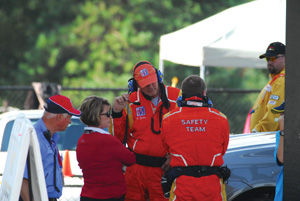 |
| John Zilles confers with a medical team after picking up a driver involved in an off-track crash. Photo by Keith Hamilton |
So, who are the professionals that work the race tracks in North America? They are firefighters, paramedics and EMTs just like us. Being recognized as a dedicated, reliable safety team member at a local race track could get you into a position on one of these travelling teams. You would have to do it for the love of the sport because the compensation won’t make you rich. But from what I’ve seen, you will come away rewarded from working closely with a dedicated team of professionals.
As a final note, the IMSA rescue crew wanted me to get the word out about an injured de Ferran Motorsports race team member named Keith Jones. Jones, of Greenwood, Ind., was injured in a pit incident in the American Le Mans Series race on July 19 at the Mid-Ohio sports car course. Jones was the team fueler and was burned in the incident. He had been a veteran crew member of the ALMS and IndyCar series teams for more than 10 years. Special racing stickers that say “Get Well Jonesie” have been produced by Shadow Graphics in Indianapolis and were on all the safety vehicles and many race cars at Mosport.
If you wish, donations and best wishes can be sent to the de Ferran Motorsports headquarters: Keith E. Jones Fund c/o De Ferran Motorsports. 485 Southpoint Circle, Suite 900 Brownsburg, IN 46112
Print this page